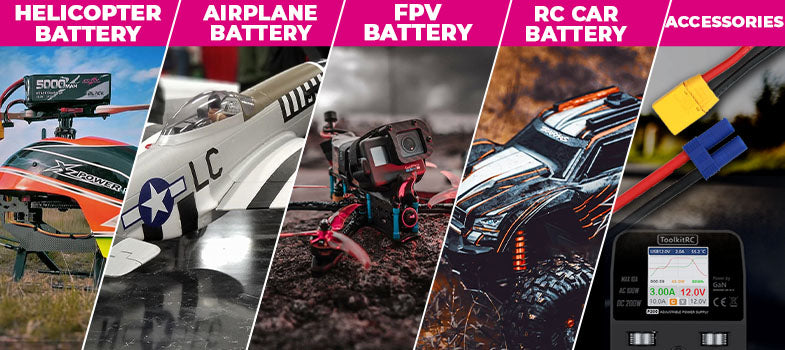
CNHL Lipo Batterien
CNHL zielt darauf ab, hochwertige Li-Po-Akkus und RC-Produkte für alle Hobby-Enthusiasten mit ausgezeichnetem Kundenservice und wettbewerbsfähigen Preisen bereitzustellen
Wenn Sie sich jemals gefragt haben, wie Sie Ihre LiHV-Akkus langfristig gesund halten, behandelt diese Anleitung das Laden, die Lagerspannung und die wichtigsten Unterschiede zu LiPo – mit klaren, praxisnahen Zahlen.

Schließen Sie immer zuerst die Ladeleitung an das Ladegerät an, dann den Akku. Vermeiden Sie es, die Ladeleitung zu trennen, während der Akku noch angeschlossen ist.
Wenn Sie nicht bald wieder fliegen/fahren, stellen Sie den Akku auf ~3,80V pro Zelle (auch Lagerspannung genannt) mit der Speicherfunktion des Ladegeräts ein. Lassen Sie den Akku vor der Lagerung abkühlen und bewahren Sie ihn an einem trockenen, feuerfesten Ort auf.
Die Spannung sinkt unter Last und erholt sich im Ruhezustand. Zum Schutz der Akkugesundheit:
F1. Kann ich einen LiHV-Akku im normalen LiPo-Modus laden?
A: Ja, aber er stoppt bei 4,20V/Zelle und Sie nutzen nicht das volle LiHV-Potenzial. Für maximale Kapazität/Leistung verwenden Sie den LiHV mode (4,35V/Zelle).
F2. Was ist die ideale Lagerspannung für einen 6S LiHV?
A: Etwa 22,8V gesamt (≈3,8V × 6). Allgemein: Gesamte Lagerspannung ≈ 3,8V × Zellanzahl.
F3. Was ist ein sicherer Mindestwert nach jedem Flug?
A: Landen Sie bei etwa 3,6–3,7V pro Zelle (im Ruhezustand). Vermeiden Sie <3,5V pro Zelle im normalen Gebrauch und längeren Betrieb nahe ~3,3V.
F4. Muss ich einen neuen LiHV vor der Lagerung vollständig laden?
A: Nein. Sie können ihn direkt auf Lagerspannung (~3,8V/Zelle) einstellen und dort belassen.
F5. Wie lange kann ein LiHV vollgeladen bleiben?
A: Halten Sie die Volladungsfenster kurz (idealerweise <24 Stunden). Bei längeren Pausen auf Lager-Spannung zurückkehren.
F6. Welche Ladeeinstellungen sollte ich überprüfen?
A: Bestätigen Sie den LiHV chemistry mode, moderaten Strom (≤1C), angeschlossenen Balancer-Anschluss und kontrollierte Temperatur.
Suchen Sie nach bewährten Hochvolt-Akkus? Durchstöbern Sie hier unsere spezielle Auswahl: CNHL High Voltage (LiHV) Battery Collection.

CNHL zielt darauf ab, hochwertige Li-Po-Akkus und RC-Produkte für alle Hobby-Enthusiasten mit ausgezeichnetem Kundenservice und wettbewerbsfähigen Preisen bereitzustellen
Spezifikationen: Lagernummer: 500706EC5 Kapazität: 5000mAh Spannung: 22,2V / 6-Zellen / 6S1P Entladestrom: 70C Dauer / 140C Spitze Ladestrom: 5C ...
Vollständige Details anzeigenSpezifikationen: Lagernummer: 1351506PZ Kapazität: 1350mAh Spannung: 22,2V / 6-Zellen / 6S1P Entladerate: 150C Dauer / 300C Spitze Laderate: Max....
Vollständige Details anzeigenSpezifikationen Lagernummer: 1301306BK Kapazität: 1300mAh Spannung: 22,2V / 6-Zellen / 6S1P Entladerate: 130C Dauerhaft / 260C Spitze Laderate: Ma...
Vollständige Details anzeigenSpezifikationen: Lagernummer: 1501204 Kapazität: 1500mAh Spannung: 14,8V / 4-Zellen / 4S1P Entladerate: 120C Dauerhaft / 240C Kurzzeitig Laderate:...
Vollständige Details anzeigenSpezifikationen: Lagernummer: 220303BK Kapazität: 2200mAh Spannung: 11.1V / 3-Zellen / 3S1P Entladerate: 30C Dauer / 60C Spitze Laderate: Max. 5C ...
Vollständige Details anzeigenCNHL Havok 1000mm 4S Sport Racer Flugzeug – gebaut auf bewährtem 1m Havok Rumpf Das CNHL Havok 1000mm 4S Sport Racer RC Flugzeug PNP ist ein 1-M...
Vollständige Details anzeigenDer MNRC MN300 ist ein 1/12 Maßstab Ready-to-Run (RTR) 4WD RC Rock Crawler, der für leichtes Klettern, Trail-Fahren und alltäglichen Offroad-Spaß...
Vollständige Details anzeigenInspiriert vom legendären britischen Jagdflugzeug des Zweiten Weltkriegs vereint das VOLANTEX Spitfire RC Flugzeug klassisches Warbird-Design m...
Vollständige Details anzeigenDas VOLANTEX BF109 4-Kanal RC-Flugzeug RTF bringt einen der ikonischsten WWII-Kampfflieger in ein kompaktes, anfängerfreundliches Paket. Mit ein...
Vollständige Details anzeigenDas Volantex RC-Flugzeug P51D V2 RTF ist ein kompaktes Jagdflugzeug im Stil des Zweiten Weltkriegs, das das Lernen des Fliegens so entspannt wie ...
Vollständige Details anzeigen
Kommentare
Hinterlassen Sie einen Kommentar